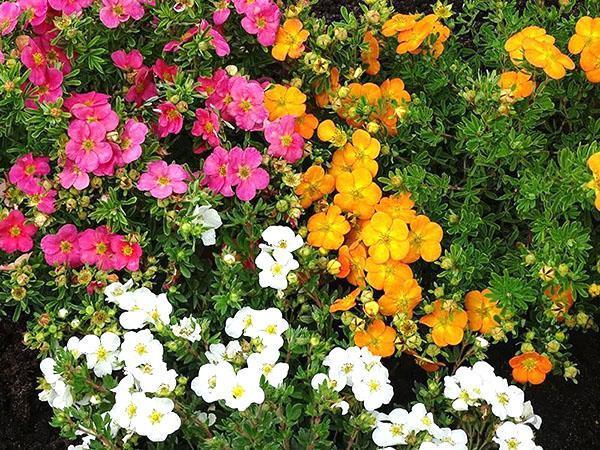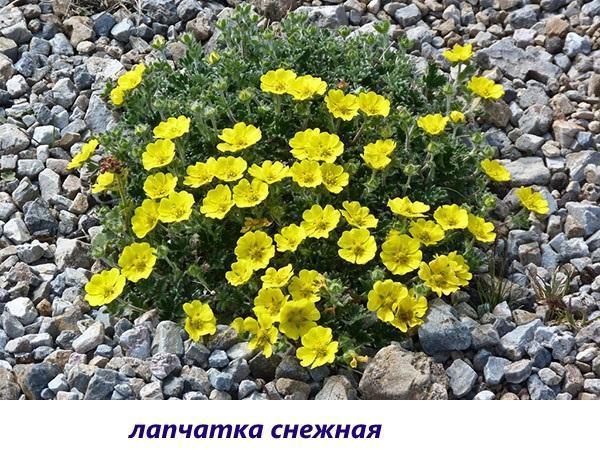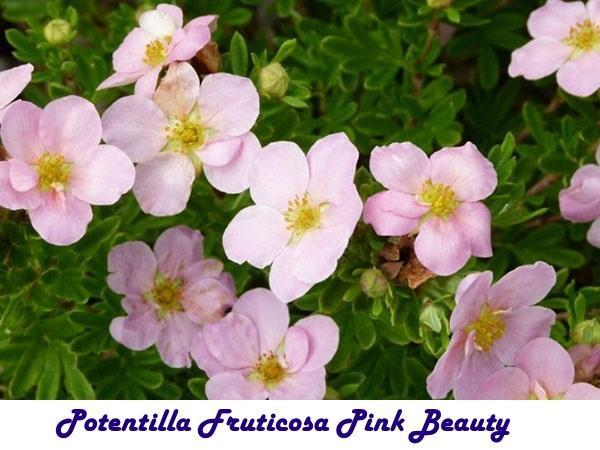Various types of Potentilla grow in their summer cottage
 In the variety of species of the temperate climatic zone, plants collected in the genus Potentilla play an important role. This is not surprising, because according to recent studies, more than 320 independent species can bear this name, among which there are one- and two-year-old crops, perennials, undersized, creeping or creeping specimens, as well as shrubs.
In the variety of species of the temperate climatic zone, plants collected in the genus Potentilla play an important role. This is not surprising, because according to recent studies, more than 320 independent species can bear this name, among which there are one- and two-year-old crops, perennials, undersized, creeping or creeping specimens, as well as shrubs.
Differing in size and shape, the plants still have a lot in common. For example, most of them are inhabitants of the Northern Hemisphere. Cinquefoil can be found in Norway and the northern Caucasus, their range stretches from Western Europe to the Far East. About a hundred varieties are found in Russia alone.
Another common feature is the split foliage, thanks to which the plant got its name, and a similar structure of flowers, reminiscent of a distant relationship with rose hips, strawberries, gravilat and plum, as well as belonging to the Pink family.

Wild species have been used in folk medicine since ancient times. Rhizomes and cinquefoil, rich in bactericidal, astringent, hemostatic substances, are used in modern medicine, as well as in the production of alcoholic beverages, canned food and in the manufacture of natural dyes.
 Today, perennial species, for example, shrub cinquefoil, varieties and hybrids obtained as a result of selection are popular with owners of household plots.
Today, perennial species, for example, shrub cinquefoil, varieties and hybrids obtained as a result of selection are popular with owners of household plots.
Potentilla plants with decorative foliage and flowers of yellow, white, pink and red shades are valued for their unpretentiousness, versatility and variety.
Goose cinquefoil (P. anserina)
 A striking representative of the genus is Potentilla goose. It is a ground cover plant that is easy to find along fences, on country roadsides, in meadows and near water bodies. Thanks to the ability to reproduce with a mustache, the culture has received the nickname "caterpillar" among the people. Due to its unpretentiousness, Potentilla should get into more or less favorable conditions, after a few years its recognizable feathery leaves and bright yellow flowers appear on the entire site.
A striking representative of the genus is Potentilla goose. It is a ground cover plant that is easy to find along fences, on country roadsides, in meadows and near water bodies. Thanks to the ability to reproduce with a mustache, the culture has received the nickname "caterpillar" among the people. Due to its unpretentiousness, Potentilla should get into more or less favorable conditions, after a few years its recognizable feathery leaves and bright yellow flowers appear on the entire site.
An elegant plant is widespread in Russia and is even used as an ornamental crop. Potentilla with yellow flowers and bright green foliage gains special value where, due to high air pollution, other species do not take root.
Erect cinquefoil (P. erecta)
 From the western borders of Russia to Altai, from the tundra in the north to the Caucasus in the south, another common species can be found. This plant, like the cinquefoil goose, is a herbaceous perennial, however, it differs in the size of the aboveground part, the appearance of flowers and leaves.
From the western borders of Russia to Altai, from the tundra in the north to the Caucasus in the south, another common species can be found. This plant, like the cinquefoil goose, is a herbaceous perennial, however, it differs in the size of the aboveground part, the appearance of flowers and leaves.
Erect cinquefoil is easy to recognize by its thin, branching stems, on which trifoliate or five-fingered leaves with serrated edges sit. Plants bloom from May. But unlike its relatives, the corolla with a diameter of 15 to 25 mm consists not of five, but of four golden petals. Flowering lasts until September. At the same time, fruits ripen, which are carried around the area by wind, rain and with the help of animals.
 In addition, the culture is an excellent melliferous plant and a source of natural spicy raw materials, thanks to which the popular name used for erect cinquefoil appeared - galangal herb or wild galangal.
In addition, the culture is an excellent melliferous plant and a source of natural spicy raw materials, thanks to which the popular name used for erect cinquefoil appeared - galangal herb or wild galangal.
Plants 15 to 50 cm high are very unpretentious. They endure trampling staunchly, feel great in direct sunlight and, thanks to the thickened lignified rhizome, winter without loss.
Silver cinquefoil (P. argentea)
 Another herbaceous perennial is silver cinquefoil. In appearance, it strongly resembles the previous plant, but somewhat lower, and its yellow flowers have traditional heels of petals. The culture got its name due to the whitish or almost gray felt cover on the stems, leaves and petioles.
Another herbaceous perennial is silver cinquefoil. In appearance, it strongly resembles the previous plant, but somewhat lower, and its yellow flowers have traditional heels of petals. The culture got its name due to the whitish or almost gray felt cover on the stems, leaves and petioles.
Small flowers, up to 10 mm in diameter, form loose inflorescences that appear in early summer. Flowering lasts from 30 to 50 days. At the same time, the collection of medicinal raw materials with antibacterial, anti-inflammatory, strengthening, hemostatic properties is carried out.
White cinquefoil (P. alba)
 The flowers of the species described above are yellow in color. It is predominant, but there are varieties with different shades of corollas. An example of this is the white cinquefoil - another European species that grows from the center of Europe to the Balkans in the south and the Urals in the east.
The flowers of the species described above are yellow in color. It is predominant, but there are varieties with different shades of corollas. An example of this is the white cinquefoil - another European species that grows from the center of Europe to the Balkans in the south and the Urals in the east.
A small perennial herb up to 25 cm in height interested flower growers at the end of the 18th century. The reason is not only long flowering, lasting from late spring to August, unpretentiousness and frost resistance, but also high decorative effect. White flowers with five petals, a yellow core and long stamens look incredibly impressive against the background of dark green palm leaves. Among its wild-growing counterparts, this type of Potentilla can be called large-flowered. Corollas reach 30 mm in diameter and look even more expressive in loose inflorescences of five flowers.
Nepalese cinquefoil (P. nepalensis)
 The era of geographical discoveries brought humanity not only acquaintance with new lands, but also with previously unknown representatives of the green world. Nepalese cinquefoil, which grows naturally in the western part of the Himalayas, interested botanists and gardeners:
The era of geographical discoveries brought humanity not only acquaintance with new lands, but also with previously unknown representatives of the green world. Nepalese cinquefoil, which grows naturally in the western part of the Himalayas, interested botanists and gardeners:
- unusually large palm leaves;
- collected in sparse inflorescences of pink or fireplace-red flowers up to 30 mm in diameter;
- shoots, like corollas, have anthocyanin coloration;
- bloom lasting up to 55 days.
Since 1820, the plant has been cultivated as an ornamental crop. On the basis of the wild-growing variety, scientists obtained large-flowered varieties that are as unpretentious and willingly blooming as their ancestors from Asia.
 An example is Miss Wilmott's cinquefoil, with its spectacular pink flowers that stand out with a dark cherry-colored eye and a web of veins radiating from the center of each petal.
An example is Miss Wilmott's cinquefoil, with its spectacular pink flowers that stand out with a dark cherry-colored eye and a web of veins radiating from the center of each petal.
Indian cinquefoil (P. indica)
 Learning more and more about the plant world, scientists sometimes make discoveries where, it would seem, everything has long been known. Not so long ago, a family known to many owners of household plots and flower growers of Duchenei, or Indian strawberries, was ranked in the Lapchatka family.
Learning more and more about the plant world, scientists sometimes make discoveries where, it would seem, everything has long been known. Not so long ago, a family known to many owners of household plots and flower growers of Duchenei, or Indian strawberries, was ranked in the Lapchatka family.
The plant was named Indian Potentilla or Potentilla indica, and it can be distinguished from real strawberries by its characteristic yellow, not white flowers, as well as by inedible fruits.
In Russian gardens, the low-maintenance Indian Potentilla is grown as an ornamental ground cover crop, decorating the site from early spring until frost.
Turber's cinquefoil (P. thurberi)
 Unique, purple flowers are possessed by the herbaceous perennial cinquefoil Turbera and the hybrid variety obtained on its basis with red wine-colored petals and a darker eye in the center of the corolla. Cinquefoil Monarch Velvet (P. Monarch's Velvet) is sun-loving, characterized by long flowering and high winter hardiness. Already in June, spectacular flowers with a diameter of up to 30 mm appear on the plant. The growing season ends only with the arrival of the cold.
Unique, purple flowers are possessed by the herbaceous perennial cinquefoil Turbera and the hybrid variety obtained on its basis with red wine-colored petals and a darker eye in the center of the corolla. Cinquefoil Monarch Velvet (P. Monarch's Velvet) is sun-loving, characterized by long flowering and high winter hardiness. Already in June, spectacular flowers with a diameter of up to 30 mm appear on the plant. The growing season ends only with the arrival of the cold.
The plant will find a place in the general flowerbed, it looks great in single plantings and will not fail if you drop it in a hanging planter.
Cinquefoil dark blood red (P. atrosanguinea or argyrophylla)
 From Nepal, dark blood-red cinquefoil also got to European flower beds. A tall herbaceous perennial, which forms erect pubescent stems, can grow up to 60 cm. The plant readily branches and begins to bloom profusely from June.
From Nepal, dark blood-red cinquefoil also got to European flower beds. A tall herbaceous perennial, which forms erect pubescent stems, can grow up to 60 cm. The plant readily branches and begins to bloom profusely from June.
Flowers up to 50 mm in diameter are clearly visible due to bright orange-red petals, often with a pronounced eye and a network of veins diverging from the center. Flowering lasts almost two months, but then Potentilla does not lose its attractiveness. Until the very frosts, the plant is decorated with trifoliate, resembling strawberry leaves with a light green outer and silvery-felt inner side.
 This species gave flower growers interesting varieties with simple, even double flowers. One of the most popular among them is P. Gibson Scarlet with carmine or crimson-red corollas, pleasing to the eye during the first half of summer.
This species gave flower growers interesting varieties with simple, even double flowers. One of the most popular among them is P. Gibson Scarlet with carmine or crimson-red corollas, pleasing to the eye during the first half of summer.
Shrub cinquefoil (P. Fruticosa)
 A real find for breeders was cinquefoil shrub or, as the plant is popularly called, five-leafed, Kalmyk or Kuril tea. Unlike herbaceous relatives, this species:
A real find for breeders was cinquefoil shrub or, as the plant is popularly called, five-leafed, Kalmyk or Kuril tea. Unlike herbaceous relatives, this species:
- forms a dense, often spherical crown and reaches a height of 60–120 cm;
- the variety of colors is striking;
- blooms nonstop for 3-4 months;
- has small, five-toed leaves;
- does not lose its aerial part during the winter period.
Thanks to culture enthusiasts, today florists have at their disposal several dozen spectacular varieties with white, yellow, pink, salmon, orange and red flowers.
 One of them is the Goldfinger Potentilla (P. fruticosa Goldfinger) shown in the photo. The fast-growing culture forms a bush 80 cm tall with a dense globular crown, smooth dark green leaves and 5 cm flowers of a rich yellow hue. Lush, non-stop flowering lasts all summer, up to frost in mid-autumn.
One of them is the Goldfinger Potentilla (P. fruticosa Goldfinger) shown in the photo. The fast-growing culture forms a bush 80 cm tall with a dense globular crown, smooth dark green leaves and 5 cm flowers of a rich yellow hue. Lush, non-stop flowering lasts all summer, up to frost in mid-autumn.
 Another noteworthy cultivar is P. fruticosa Red Ace. Bred in the UK, the variety has a compact, wide-rounded crown up to 60 cm in height and about 100 cm in diameter.
Another noteworthy cultivar is P. fruticosa Red Ace. Bred in the UK, the variety has a compact, wide-rounded crown up to 60 cm in height and about 100 cm in diameter.
Not afraid of polluted city air, frost and easily tolerating a haircut, the culture prefers the sun or partial shade, reacts well to watering and blooms profusely throughout the warm season.
Orange or salmon flowers of this variety look great against a background of smooth, fairly light foliage.
 Lovers of red flowers, which perfectly enliven their garden plot, will like P. fruticosa Marion Red Robin. The shrub form is distinguished by its small size. A dense crown, not exceeding 50 cm in height, can grow up to 80 cm wide. Brownish shoots are densely covered with small light green foliage, against which large flowers of a saturated scarlet hue look doubly advantageous. The variety is versatile and can be used both in single and in group plantings.
Lovers of red flowers, which perfectly enliven their garden plot, will like P. fruticosa Marion Red Robin. The shrub form is distinguished by its small size. A dense crown, not exceeding 50 cm in height, can grow up to 80 cm wide. Brownish shoots are densely covered with small light green foliage, against which large flowers of a saturated scarlet hue look doubly advantageous. The variety is versatile and can be used both in single and in group plantings.
Shrub Potentilla shows itself perfectly in low borders, on slopes and in large flowerpots. To maintain its shape, the plant can be cut, while flowering is quickly and completely restored.
 The most beautiful variety with white flowers is considered to be the Abbotswood Potentilla (P. fruticosa Abbotswood). Compared to the varieties described above, this plant cannot be called compact. An adult bush reaches a height of about 100 cm and a diameter of 130–150 cm. From the beginning of spring, the crown, which resembles a dense pillow, is covered with small light green foliage, and already in June large spectacular flowers of a pure white tone with a yellow core and stamens raised above the corolla appear.
The most beautiful variety with white flowers is considered to be the Abbotswood Potentilla (P. fruticosa Abbotswood). Compared to the varieties described above, this plant cannot be called compact. An adult bush reaches a height of about 100 cm and a diameter of 130–150 cm. From the beginning of spring, the crown, which resembles a dense pillow, is covered with small light green foliage, and already in June large spectacular flowers of a pure white tone with a yellow core and stamens raised above the corolla appear.
Flowering lasts until September, and when planted in the sun, the plant feels much better than in partial shade, blooms longer and more abundantly. In the spring, the shrub is recommended to be sheared.
The use of Potentilla in garden design
 Both herbaceous and shrub forms of plants are desirable in any flower bed.Due to its moderate exactingness, rapid growth and willing flowering, Potentilla can be successfully grown in any climatic zone of Russia, the main thing is to choose the right varieties and learn about some general preferences of the culture.
Both herbaceous and shrub forms of plants are desirable in any flower bed.Due to its moderate exactingness, rapid growth and willing flowering, Potentilla can be successfully grown in any climatic zone of Russia, the main thing is to choose the right varieties and learn about some general preferences of the culture.
Suitable for Potentilla:
- well-drained, moderately moist soil;
- an area in the sun or in a light shade, where the plant is not at risk of flooding and decay;
- flowerbed, curb or rabatka in urban areas, since the plant is not afraid of smoke and high concentration of dust and exhaust gases in the air.
All types of Potentilla are rarely affected by pests, they winter well, especially with a dry preventive cover of the root system.
 The lack of smell and long-term flowering make it possible to plant shrubs and herbaceous species next to children's, educational and medical institutions, in crowded squares and in the courtyards of residential buildings. A variety of varieties, especially the appearance of semi- and double varieties, guarantees the uniqueness of the landscape design and the pride of the owner of the site.
The lack of smell and long-term flowering make it possible to plant shrubs and herbaceous species next to children's, educational and medical institutions, in crowded squares and in the courtyards of residential buildings. A variety of varieties, especially the appearance of semi- and double varieties, guarantees the uniqueness of the landscape design and the pride of the owner of the site.